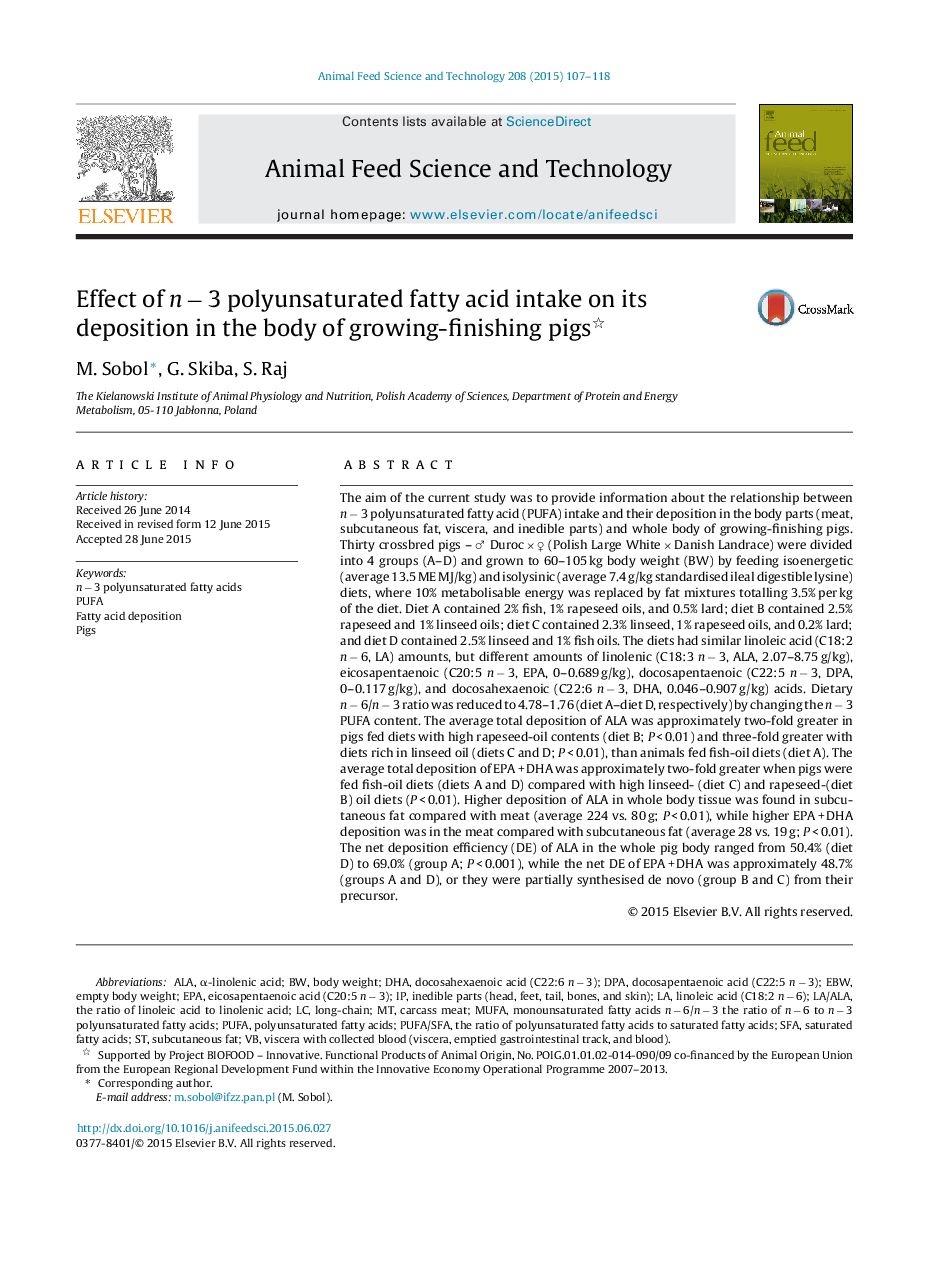| Article ID | Journal | Published Year | Pages | File Type |
|---|---|---|---|---|
| 2419491 | Animal Feed Science and Technology | 2015 | 12 Pages |
•Fatty acids composition in the pig body is related to their composition in the diet.•The increase of n − 3 PUFA intake increased their deposition in the pig body.•The deposition of n − 3 PUFA in the body depended on the source of fat in the diet.•The increase of n − 3 PUFA intake reduced its net deposition efficiency by pigs.•Diet with linseed and fish oils the best improved body fatty acids composition.
The aim of the current study was to provide information about the relationship between n − 3 polyunsaturated fatty acid (PUFA) intake and their deposition in the body parts (meat, subcutaneous fat, viscera, and inedible parts) and whole body of growing-finishing pigs. Thirty crossbred pigs – ♂ Duroc × ♀ (Polish Large White × Danish Landrace) were divided into 4 groups (A–D) and grown to 60–105 kg body weight (BW) by feeding isoenergetic (average 13.5 ME MJ/kg) and isolysinic (average 7.4 g/kg standardised ileal digestible lysine) diets, where 10% metabolisable energy was replaced by fat mixtures totalling 3.5% per kg of the diet. Diet A contained 2% fish, 1% rapeseed oils, and 0.5% lard; diet B contained 2.5% rapeseed and 1% linseed oils; diet C contained 2.3% linseed, 1% rapeseed oils, and 0.2% lard; and diet D contained 2.5% linseed and 1% fish oils. The diets had similar linoleic acid (C18:2 n − 6, LA) amounts, but different amounts of linolenic (C18:3 n − 3, ALA, 2.07–8.75 g/kg), eicosapentaenoic (C20:5 n − 3, EPA, 0–0.689 g/kg), docosapentaenoic (C22:5 n − 3, DPA, 0–0.117 g/kg), and docosahexaenoic (C22:6 n − 3, DHA, 0.046–0.907 g/kg) acids. Dietary n − 6/n − 3 ratio was reduced to 4.78–1.76 (diet A–diet D, respectively) by changing the n − 3 PUFA content. The average total deposition of ALA was approximately two-fold greater in pigs fed diets with high rapeseed-oil contents (diet B; P < 0.01) and three-fold greater with diets rich in linseed oil (diets C and D; P < 0.01), than animals fed fish-oil diets (diet A). The average total deposition of EPA + DHA was approximately two-fold greater when pigs were fed fish-oil diets (diets A and D) compared with high linseed- (diet C) and rapeseed-(diet B) oil diets (P < 0.01). Higher deposition of ALA in whole body tissue was found in subcutaneous fat compared with meat (average 224 vs. 80 g; P < 0.01), while higher EPA + DHA deposition was in the meat compared with subcutaneous fat (average 28 vs. 19 g; P < 0.01). The net deposition efficiency (DE) of ALA in the whole pig body ranged from 50.4% (diet D) to 69.0% (group A; P < 0.001), while the net DE of EPA + DHA was approximately 48.7% (groups A and D), or they were partially synthesised de novo (group B and C) from their precursor.
